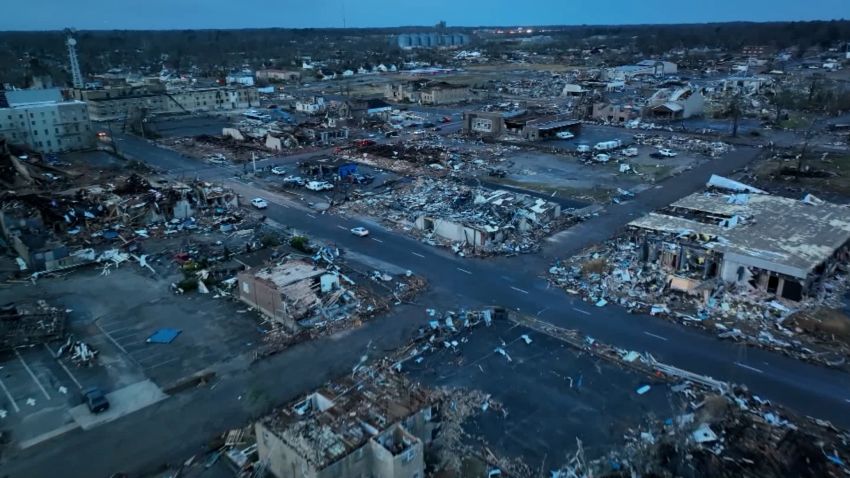Editor’s Note: Joshua Wurman is an atmospheric scientist, tornado researcher and the inventor of the Doppler On Wheels mobile radars. He is the director of the University of Illinois Flexible Array of Radars and Mesonets (FARM) Facility and works out of Boulder, Colorado. The views expressed in this commentary are his own. View more opinion on CNN.
On Saturday, tornado scientists like myself woke to horrible news: Dozens of people had been killed in a devastating system of more than 50 tornadoes that spread across several states. The hardest-hit areas appeared to be in Kentucky, where Gov. Andy Beshear said he believes more than 80 people have died in what he called “the most devastating tornado event” in the state’s history.

Alongside other experts in the field, I’ve spent much of my life trying to learn more about tornadoes to make them more predictable and hopefully prevent tragedies like this. For nearly three decades, I’ve observed 300 tornadoes with mobile Doppler On Wheels (DOW) radars, mapping their destructive winds in an effort to understand exactly how, when and why they form, and why a few become monstrous with winds up to 300 mph. My colleagues and I work to develop better equations, better computer forecasting models, better ways to warn people and better options for shelter.
Through our research, we’ve learned a lot about why tornadoes are still so deadly despite our ability to predict them – and what we can do to better protect ourselves from their devastation.
A flawed warning system
If a tornado is not well forecast and there is little or no warning, that’s an obvious risk. Today, however, most major tornado outbreaks are forecast well ahead of time. The warning for Mayfield, Kentucky was issued about 20 minutes before the tornado hit, and the storm had been producing warned tornadoes for well over an hour.
But timing is only part of the battle. If people don’t hear or understand the warning, it can’t be effective. Warnings are announced with sirens, on television and on Twitter, but some people – and sometimes the most vulnerable – still miss out. Some of the elderly, the poor and those with disabilities may be less “connected,” or less able to process the warnings. Some may not understand English. While efforts are being made to increase the inclusiveness of warnings, there is a long way to go. In this recent outbreak, we don’t yet know how well the warnings reached all of the people who were at risk.
Another issue is that tornado forecasts are often very broad, making it hard for people to decipher the severity of the threat. For about 70% of tornado warnings, no tornado occurs at all. Worse, even when a tornado does occur in the warned area, I’ve seen in my research that usually less than 1% of the warned area is affected. With this recent tornado event, my analysis shows that about 20,000 square miles across several states were tornado-warned, which would include more than a million people in parts of the cities of Nashville and Memphis, Tennessee, and St. Louis. But tornadoes are small, almost always less than a mile wide, and damage tracks are narrow. Even in this unusually bad outbreak, direct tornado impacts appear to have been felt by only a fraction of the people who were warned.
Amplifying this problem of broad tornado warnings is that there is little nuance. All tornadoes are not alike. Some are relatively weak, with winds of 100 mph, capable of downing some trees and damaging roofs, while others have winds near 300 mph, flattening all but the strongest buildings.
Since we have very little ability to forecast how strong a tornado will become, warnings nearly always describe the worst outcomes. This is in stark contrast to warnings for, say, a winter storm, where in my observation the odds are more than 50/50 that it will snow, and a forecast can specify whether to expect one inch or one foot. With hurricanes, communities will take different actions depending on whether a Category 1 versus a Category 5 storm is in the forecast. But with tornadoes, no such detail exists – and people may become complacent to warnings, having experienced false alarms.
Solving this over-warning problem is not easy. Efforts were made several years ago to reduce the false alarm rate with tornado warnings, yet this led to shorter average lead times and even unwarned tornadoes. And because the precise path of tornadoes is not known, some tornadoes can curve and “escape” narrower, more precise warning areas and impact unprepared people.
Even when there’s plenty of advance warning of a tornado, and people try to take action, it’s still sometimes difficult to find a place of safety. A typical home shelter costs several thousand dollars, which may be out of reach for many. And those who can least afford shelters often live in the weakest houses. Cost is, of course, also a factor for schools and industry.
Improving our safety odds
That said, there are measures we can take to make these tragedies less frequent.
More research will increase our understanding of how the most intense tornadoes form, and how to forecast them better, earlier and with more nuance. Being able to give an hour warning ahead of a tornado and being able to say whether it is strong versus weak would allow people to seek sturdier shelters, or even to evacuate from the path in the rare cases where conventional sheltering would not be enough.
Toward this goal, tornado scientists are preparing for the largest-ever study of tornadoes in the Southeast, called PERiLS – which stands for Propagation Evolution and Rotation in Linear Storms – supported by the National Science Foundation and the National Oceanographic and Atmospheric Administration. We’ll be converging in the Southeast during the peak of tornado season in March and April 2022 and 2023, driving multiple DOW and DOW-like radar trucks, launching hundreds of weather balloons and deploying dozens of weather stations to observe Southeastern tornadic storms with more detail than ever before. The major goal of PERiLS is to learn how, when and why these deadly tornado outbreaks occur, and how we can better forecast them and communicate warnings to the public.
There is a strong burden on those issuing tornado warnings to be more precise and nuanced with sounding the alarm; we can’t always be “better safe than sorry.” But improving forecasts and warnings will be a complex task that will take time to refine.
As scientists navigate that challenge, we can do reasonable things right now to try to maximize our safety. To start, communities and industries need to improve and expand tornado shelter infrastructure to make buildings more resistant to tornadoes. With ongoing research, thinking critically about how we distribute warnings and helping the public better respond to those warnings when they’re issued, it is possible to make mass casualty tornado events much less common.





